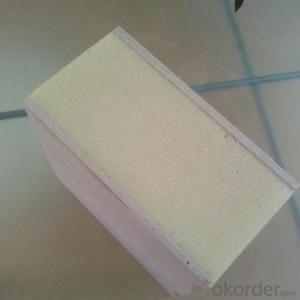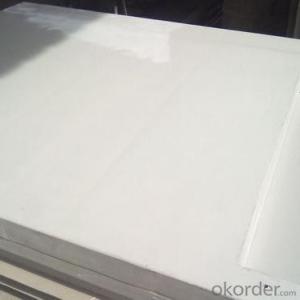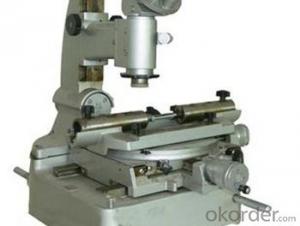Fiberglass Pultruded Profile Frp Profile
- Loading Port:
- Tianjin
- Payment Terms:
- TT OR LC
- Min Order Qty:
- 300 m
- Supply Capability:
- 50000 m/month
OKorder Service Pledge
OKorder Financial Service
You Might Also Like
Item specifice
PRODUCT DESCRIPTION
Fiber-reinforced plastic (FRP) (also fiber-reinforced polymer) is a composite material made of a polymer matrix reinforced with fibers. The fibers are usually fiberglass, carbon, or aramid, while the polymer is usually an epoxy, vinylester or polyester thermosetting plastic.
According to customer demand, we can design different functional properties of glass fiber products, carbon fiber products, aramid fiber products and other composite materials products. The scope of products wide range of areas, including: tents, windsurfing, yachting, sports equipment, transportation, communications, electronics, model airplanes, new energy, building materials and other fields.
Create composite materials, composite materials to guide development of the industry total cohesion fiberglass's mission and values.
FEATURES
1.corrosion resistant
2.lightweight,
3.extremely strong and durable
4.mainly used for power&chemical plant
5.high strehght
6.good flexibility
7.aging resistant
8.corrosion resistant
SPECIFICATIONS
Item | FRP | PVC | Aluminum alloy | Steel | Wood |
Tensile strength(mpa) | 350 | 50 | 140 | 290 | 6 |
Tensile modulus(mpa×104) | 4 | 1.6 | 6 | 20 | 0.8 |
Density(g/cm3) | 1.8 | 1.2 | 2.7 | 7.8 | 0.4 |
Thermal conductivity(w/n•0C) | 1.3 | 2 | 220 | 85 | 0.8 |
Coefficient of li near expansion(1/℃) | 0.7×10-4 | 62×10-4 | 22×10-6 | 10×10-4 | 10×10-4 |
Heat resistance(℃) | 130 | 70 | 200 | 300 | |
Appearance | Colorful | ||||
Sevice life(year) | 50 | 15 | 25 | 10 | 10 |
Corrosion resistance | A | B | C | D | E |
PICTURES
- Q:What are the load-bearing capabilities of FRP pultrusion profiles?
- FRP (Fiber Reinforced Polymer) pultrusion profiles have excellent load-bearing capabilities. The load-bearing capacity of FRP pultrusion profiles is determined by several factors such as the type and arrangement of fibers, resin properties, and the overall design of the profile. FRP pultrusion profiles are commonly used in various industries due to their high strength-to-weight ratio. The reinforcing fibers, typically made of materials such as fiberglass or carbon fiber, provide the profile with exceptional tensile and flexural strength. These fibers are embedded in a resin matrix, which further enhances the load-bearing capabilities of the profile. The load-bearing capacity of FRP pultrusion profiles can be tailored to meet specific requirements by adjusting the fiber type, orientation, and resin properties during the manufacturing process. This allows for a wide range of design possibilities and enables engineers to optimize the profiles for different applications. Furthermore, FRP pultrusion profiles exhibit excellent resistance to corrosion, making them suitable for use in harsh environments. Unlike traditional materials such as steel or wood, FRP profiles do not rust or rot, ensuring long-term durability and structural integrity. Overall, the load-bearing capabilities of FRP pultrusion profiles are highly impressive, making them a reliable choice for various load-bearing applications such as structural supports, bridges, platforms, and industrial equipment.
- Q:Can FRP pultrusion profiles be used in the construction of train or subway platforms?
- Yes, FRP (Fiber Reinforced Polymer) pultrusion profiles can be used in the construction of train or subway platforms. FRP pultrusion profiles are made of a combination of reinforced fibers and a polymer resin matrix, which gives them high strength and durability. These profiles are lightweight, corrosion-resistant, and have excellent mechanical properties, making them suitable for various applications in the construction industry. When it comes to train or subway platforms, FRP pultrusion profiles can be used for various structural components such as handrails, guardrails, gratings, and decking systems. These profiles provide a non-conductive and non-magnetic solution, which is essential in railway environments to prevent interference with electrical and signaling systems. Furthermore, FRP pultrusion profiles offer a high level of customization, allowing them to be tailored to specific project requirements. They can be manufactured in various shapes, sizes, and colors to meet the aesthetic and functional needs of train or subway platforms. Moreover, FRP pultrusion profiles have excellent resistance to environmental factors such as moisture, chemicals, and UV radiation. This resistance ensures that the profiles remain durable and maintain their structural integrity over time, even in harsh and corrosive conditions commonly found in railway environments. Overall, FRP pultrusion profiles are a reliable and cost-effective choice for the construction of train or subway platforms. They provide numerous advantages including strength, durability, customization options, and resistance to environmental factors, making them a suitable alternative to traditional materials in these applications.
- Q:Can FRP pultrusion profiles be used in the mining and mineral processing industry?
- The mining and mineral processing industry can indeed utilize FRP (Fiber Reinforced Polymer) pultrusion profiles. These profiles possess multiple properties that render them suitable for application in this industry. To begin with, FRP pultrusion profiles are characterized by their lightweight yet remarkably strong composition. This quality makes them ideal for situations where weight reduction holds significance, such as in mining equipment or processing plants. Despite their lightweight nature, FRP profiles can endure substantial loads and withstand corrosion. This is particularly advantageous in the mining industry, where equipment is exposed to harsh environments and corrosive substances. Furthermore, FRP pultrusion profiles are non-conductive with exceptional electrical insulation properties. This proves beneficial in mining and mineral processing operations, where electrical safety takes precedence. FRP profiles can be utilized in scenarios where electrical conductivity must be avoided, such as in electrical enclosures or cable trays. Moreover, FRP pultrusion profiles exhibit high chemical resistance, including resistance to acids and alkalis. This renders them suitable for deployment in mineral processing plants, where various corrosive chemicals are employed in mineral extraction and processing. FRP profiles can withstand exposure to these chemicals without deteriorating or sustaining significant damage, consequently increasing their lifespan and reducing maintenance costs. Additionally, FRP pultrusion profiles possess a high strength-to-weight ratio, enabling the construction of durable and lightweight structures. This proves particularly advantageous in mining operations, where structures like walkways, ladders, and platforms need to be installed in challenging terrains. The lightweight nature of FRP profiles facilitates easier transportation, handling, and installation compared to traditional materials like steel. In conclusion, FRP pultrusion profiles offer a viable option for various applications in the mining and mineral processing industry due to their lightweight composition, high strength, corrosion resistance, electrical insulation, and chemical resistance properties. These profiles present numerous advantages over traditional materials, making them a feasible choice for implementation in this industry.
- Q:Can FRP pultrusion profiles be used in the construction of chemical processing equipment?
- FRP pultrusion profiles have the capability to be utilized in the construction of chemical processing equipment. These profiles possess multiple advantages that render them suitable for such applications. To begin with, FRP pultrusion profiles exhibit a high resistance to corrosion, making them an ideal choice for chemical environments where exposure to corrosive substances is frequent. Unlike conventional materials like steel, FRP pultrusion profiles do not rust or corrode, resulting in an extended service life and reduced maintenance costs. Moreover, FRP pultrusion profiles are both lightweight and strong, providing exceptional structural integrity and load-bearing capacity. This is particularly crucial in chemical processing equipment, where the materials employed must endure high pressures and temperatures. The strength of FRP pultrusion profiles permits the construction of sturdy and durable equipment. Furthermore, FRP pultrusion profiles offer flexibility in design, allowing for customization of shapes and sizes to fulfill specific requirements. This permits the construction of intricate chemical processing equipment with complex designs that are not easily achievable using traditional materials. Additionally, FRP pultrusion profiles possess excellent electrical insulation properties, which can be advantageous in chemical processing equipment where minimizing electrical conductivity is necessary to prevent unwanted reactions or hazards. In conclusion, FRP pultrusion profiles are a dependable and cost-effective option for constructing chemical processing equipment. Their corrosion resistance, strength, design flexibility, and electrical insulation properties make them suitable for a wide range of applications in the chemical industry.
- Q:Are FRP pultrusion profiles suitable for the manufacturing of boat hulls?
- Boat hulls can be effectively manufactured using FRP pultrusion profiles. These profiles possess numerous advantages that render them perfect for constructing boat hulls. Firstly, FRP pultrusion profiles are not only lightweight but also exceptionally sturdy and durable. Consequently, they are well-suited for boat hulls as their lightweight nature enhances fuel efficiency and enables increased speed. Moreover, their impressive strength-to-weight ratio guarantees that the boat can endure the rigors of the water without compromising its structural integrity. Secondly, FRP pultrusion profiles exhibit exceptional resistance to corrosion. This characteristic is of utmost importance for boat hulls, which are constantly exposed to water, salt, and other corrosive agents. The corrosion resistance of FRP pultrusion profiles ensures that the boat hull remains intact and maintains its performance over time, thus minimizing the need for frequent maintenance and repairs. Furthermore, FRP pultrusion profiles offer great design flexibility. They can be effortlessly molded into diverse shapes and sizes, thereby facilitating customization and optimization of boat hull designs. This flexibility empowers boat manufacturers to create hulls that are both functional and visually appealing. In addition to their strength, durability, corrosion resistance, and design flexibility, FRP pultrusion profiles also possess excellent electrical and thermal insulation properties. These properties are particularly important for boat hulls as they effectively prevent the passage of electrical currents and heat through the hull, thereby ensuring the safety and comfort of passengers and crew. Overall, FRP pultrusion profiles present an outstanding solution for boat hull manufacturing. Their lightweight, robust, and corrosion-resistant attributes, in conjunction with their design flexibility and insulation capabilities, make them an ideal choice for boat manufacturers seeking to produce high-performance and long-lasting vessels.
- Q:Are FRP pultrusion profiles suitable for the manufacturing of antenna masts?
- Yes, FRP pultrusion profiles are suitable for the manufacturing of antenna masts. FRP pultrusion profiles offer several advantages such as high strength-to-weight ratio, corrosion resistance, and excellent electrical insulation properties. These characteristics make them ideal for antenna mast construction, as they can withstand various environmental conditions and provide reliable support for antennas.
- Q:Are FRP pultrusion profiles non-conductive?
- FRP pultrusion profiles are non-conductive because they consist of reinforced fibers, usually fiberglass, and a polymer resin matrix. The fiberglass fibers provide strength and stiffness, while the polymer resin acts as a binder. One of the main advantages of FRP pultrusion profiles is their excellent electrical insulation properties. Unlike metals, which conduct electricity, FRP profiles do not. This makes them ideal for applications that require electrical insulation. In addition to being non-conductive, FRP pultrusion profiles also offer other advantages like corrosion resistance, a high strength-to-weight ratio, and low maintenance requirements. These properties make them suitable for various applications such as electrical and telecom infrastructure, chemical processing plants, bridges, and building construction. It is worth noting that while FRP pultrusion profiles are non-conductive by default, they can be made conductive if necessary. Special additives or coatings can be added during the manufacturing process to give them conductive properties.
- Q:Are FRP pultrusion profiles suitable for the manufacturing of chemical pumps?
- Yes, FRP pultrusion profiles are suitable for the manufacturing of chemical pumps. FRP (Fiber Reinforced Polymer) pultrusion profiles offer several advantages that make them ideal for use in chemical pump manufacturing. Firstly, FRP pultrusion profiles are highly corrosion-resistant. Chemical pumps are frequently exposed to corrosive chemicals, which can cause damage and deterioration to traditional metal pump components. However, FRP pultrusion profiles are made from a combination of fiber reinforcements and a polymer resin matrix, which makes them highly resistant to corrosion from various chemicals. This makes FRP pultrusion profiles an excellent choice for ensuring the longevity and durability of chemical pumps. Secondly, FRP pultrusion profiles have excellent mechanical properties. They have a high strength-to-weight ratio, which means they can withstand high pressures and loads without adding significant weight to the pump. This is important for chemical pumps that need to handle heavy-duty applications and maintain their performance over time. Additionally, FRP pultrusion profiles offer design flexibility. They can be manufactured in various shapes and sizes, allowing for customized designs that meet specific pump requirements. This versatility in design enables manufacturers to optimize the pump performance and efficiency. Moreover, FRP pultrusion profiles are electrically non-conductive. This is particularly advantageous in chemical pump applications, where the presence of electricity can pose a safety risk. By using FRP pultrusion profiles, the risk of electrical accidents is minimized, ensuring a safer working environment. In summary, FRP pultrusion profiles are well-suited for the manufacturing of chemical pumps. Their corrosion resistance, excellent mechanical properties, design flexibility, and electrical non-conductivity make them a reliable and efficient choice for ensuring the performance, durability, and safety of chemical pumps in various industrial applications.
- Q:What is the torsional strength of FRP pultrusion profiles?
- The torsional strength of FRP pultrusion profiles can vary depending on the specific composition and design of the profile. However, in general, FRP pultrusion profiles tend to have high torsional strength due to the inherent properties of the fiber-reinforced polymers used in their construction. These materials are known for their excellent resistance to torsional forces, which makes FRP pultrusion profiles suitable for applications requiring high torsional strength.
- Q:Are FRP pultrusion profiles suitable for the manufacturing of boat hulls?
- Boat hulls can be effectively manufactured using FRP pultrusion profiles. These profiles possess numerous advantages that render them perfect for constructing boat hulls. Firstly, FRP pultrusion profiles are not only lightweight but also exceptionally sturdy and durable. Consequently, they are well-suited for boat hulls as their lightweight nature enhances fuel efficiency and enables increased speed. Moreover, their impressive strength-to-weight ratio guarantees that the boat can endure the rigors of the water without compromising its structural integrity. Secondly, FRP pultrusion profiles exhibit exceptional resistance to corrosion. This characteristic is of utmost importance for boat hulls, which are constantly exposed to water, salt, and other corrosive agents. The corrosion resistance of FRP pultrusion profiles ensures that the boat hull remains intact and maintains its performance over time, thus minimizing the need for frequent maintenance and repairs. Furthermore, FRP pultrusion profiles offer great design flexibility. They can be effortlessly molded into diverse shapes and sizes, thereby facilitating customization and optimization of boat hull designs. This flexibility empowers boat manufacturers to create hulls that are both functional and visually appealing. In addition to their strength, durability, corrosion resistance, and design flexibility, FRP pultrusion profiles also possess excellent electrical and thermal insulation properties. These properties are particularly important for boat hulls as they effectively prevent the passage of electrical currents and heat through the hull, thereby ensuring the safety and comfort of passengers and crew. Overall, FRP pultrusion profiles present an outstanding solution for boat hull manufacturing. Their lightweight, robust, and corrosion-resistant attributes, in conjunction with their design flexibility and insulation capabilities, make them an ideal choice for boat manufacturers seeking to produce high-performance and long-lasting vessels.
1. Manufacturer Overview |
|
|---|---|
| Location | |
| Year Established | |
| Annual Output Value | |
| Main Markets | |
| Company Certifications | |
2. Manufacturer Certificates |
|
|---|---|
| a) Certification Name | |
| Range | |
| Reference | |
| Validity Period | |
3. Manufacturer Capability |
|
|---|---|
| a)Trade Capacity | |
| Nearest Port | |
| Export Percentage | |
| No.of Employees in Trade Department | |
| Language Spoken: | |
| b)Factory Information | |
| Factory Size: | |
| No. of Production Lines | |
| Contract Manufacturing | |
| Product Price Range | |
Send your message to us
Fiberglass Pultruded Profile Frp Profile
- Loading Port:
- Tianjin
- Payment Terms:
- TT OR LC
- Min Order Qty:
- 300 m
- Supply Capability:
- 50000 m/month
OKorder Service Pledge
OKorder Financial Service
Similar products
New products
Hot products
Related keywords


































